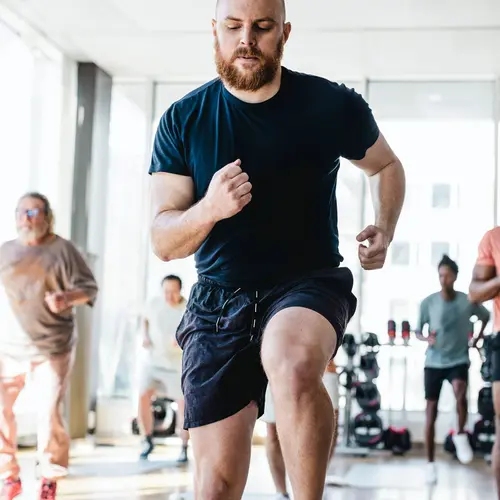Both walking and running are great ways to get cardiovascular exercise. But is one a better exercise than the other?
Benefits of Cardio Exercise
Cardio, or aerobic, exercise is anything that gets you breathing harder and your heart beating faster.
Some of the benefits of a cardio workout include:
- Reduced risk of dementia
- Improved memory
- Increased circulation
- Better blood sugar control
- Happier mood
- An easier time falling asleep
- Healthier cholesterol levels
- Better erectile function
For many people, running is a vigorous exercise, while walking tends to be moderate in intensity.
Vigorous activity is when you’re breathing fast and hard, and your heart rate has gone up a lot. You may also find it hard to say more than a few words without stopping to take a breath.
In general, one minute of vigorous activity is equal to 2 minutes of moderate-intensity activity.
Experts recommend that you get at least 150 minutes of moderate exercise or 75 minutes of vigorous exercise each week. They also say you should do muscle-strengthening activities on two or more days a week.
Walking vs. Running
There are some key differences between walking and running.
Starting exercise. If you’re just getting into exercise or are out of shape, start with walking short distances, then gradually increase your distance and duration. Even walking at a casual pace of 2 miles per hour can cut your risk of heart problems by 31%, if you do it regularly.
Burning calories. Running burns more than twice as many calories per minute as walking.
For a person who weighs 160 pounds, walking at a pace of 3.5 miles per hour for 30 minutes burns about 156 calories. Running at 6 mph for the same time burns about 356 calories.
Low impact vs. high impact. You might think of walking as just running slowly. But when you walk, you have one foot on the ground at all times. When you run, you’re in the air during each stride. Each time you land, your body absorbs the impact of about three times your body weight.
Osteoarthritis risk. Because it's more strenuous, you might think that running would increase your risk of osteoarthritis. Osteoarthritis happens when the cushion between your bones (cartilage) wears down, and your joints get painful and swollen.
But a study of 74,752 runners and 14,625 walkers found that the runners had a lower risk of hip replacement and osteoarthritis than the walkers. Researchers said that this may be because, on average, the runners had lower body mass indices (BMI) than the walkers. Less body weight means less stress on your bones.
Risk of injury. Researchers say runners and others who do high-impact exercise are more likely to get injured than walkers. But it’s hard to say exactly how much higher the risk is. Various studies have found that between 19% and 79% of runners get hurt while running.
About 80% of running injuries are overuse injuries. Researchers found that running just once a week may lead to overuse injuries. Those who run farther and more often are also more prone to injuries.
A previous leg injury puts you at higher risk for running-related leg injuries. Researchers found that orthotics and shoe inserts aren’t good at preventing running injuries.
Common running injuries include:
- Runner's knee
- Achilles tendonitis
- Shin splints
- Plantar fasciitis
- Stress fractures
- Iliotibial band syndrome
Walkers have a much lower risk of getting hurt. In a study of 14,536 college students who did various types of physical activity, those who walked had some of the lowest rates of injury.
Both Running and Walking Are Great Forms of Exercise
Scientists who looked at information from 33,060 runners and 15,945 walkers found that walking can lower your risk of diabetes, high cholesterol, and high blood pressure as much as running. They measured exercise by time, not distance.
Since walking is less vigorous than running, you’ll have to walk longer or more often to get the same benefits. Running is more efficient, but has a higher risk of injuries, and you’ll need more time to heal if you get injured.
The best exercise for you is the one you’ll actually do. So whether it’s running, walking, or both, pick the one you like best.
How to Get More Out of Your Walk
Here are some ways to improve your walking workout.
Walk in a group. Walking with friends or family can make it more fun. It can also help you stick to your exercise plan.
Swing your arms. Bend your arms at 90 degrees and swing your arms naturally as you walk. Swinging them vigorously encourages you to walk faster. It also gives your upper body more of a workout. You’ll burn 5% to 10% more calories, too.
Try incline walking. If you walk on a treadmill, increase the incline by 5% or 10%. If you walk outdoors, look for hills or even a steep driveway to make your walk more challenging.
Water walking. Do this in shallow water at the beach or in a pool. The resistance of the water increases the intensity of your walk but lessens the impact on your joints.
Walking poles. Walking poles can help you burn up to 30% more calories. They add intensity and help you maintain good posture as you walk.
Weighted vests. A weighted vest adds intensity but doesn’t strain your shoulders and wrists like ankle and hand weights do. Pick one that’s 5% to 10% of your body weight.

